As an Amazon Associate, we earn from qualifying purchases with no additional costs for you.
Keeping your Japanese knives sharp is an important part of their care and maintenance. Not only will this make sure they are always sharp and ready to use, but it will prevent you from being tempted to use a dull knife. There is much information available around sharpening Japanese knives, but you may want to find you if using a hone, steel, ceramic, or otherwise on your Japanese knife is a good idea or not. Should you hone your Japanese knife?
You should hone your Japanese knives but using the correct method to hone your knife is important. Honing steels or honing rods can be used on knives that have been hardened up to 59HRC. Knives that are hardened above this point benefit more from honing on a strop or a high-grit whetstone.
Owning a Japanese kitchen knife comes with a responsibility to keep the knife well-maintained and sharp. We often hear about the ways to sharpen our Japanese kitchen knives, and in particular, whetstones are the best way to achieve this.
However, the process of honing is different from sharpening a knife. What method of honing is most beneficial and appropriate to use on a Japanese kitchen knife?
If you are interested in checking out the best honing steels for Japanese knives we recommend you can find them by clicking here (Amazon link).

What Does Honing A Knife Do?
Honing is a different process to sharpening a knife, even though it does sharpen a knife. The process of honing a knife is to fine-tune the edge of a knife that is already sharp. Honing is not a process that is intended to be used to sharpen a dull knife.
When a sharp knife gets used, the edge can roll over slightly or lose a little of its keenness. It is still sharp but does not perform quite as it should. This is when honing a knife is appropriate.
Honing does remove steel from the edge of the knife, but it removes much less than what a whetstone removes.
Honing can be viewed as a less aggressive type of sharpening and, therefore, can be done more frequently on the edge of the knife to keep it as sharp as possible.
Regular honing of the knife will also reduce the frequency with which you will have to take your knife to the whetstone to sharpen.
Sharpening is more aggressive and removes more steel. Thus, if regular honing of your knife reduces the number of times you need to sharpen it, then honing can be seen as a way to extend the longevity of your knife.
There are several honing methods you can use to hone the edge of your knife, and the method you use will largely depend on your knife.
Especially the steel it is made from and the hardness level that the steel has been taken to through the hardening and tempering process.
TIP: If knife sharpening whetstones confuse you, we have an article that explains the options, compares the alternatives, and helps you decide which is best for your needs.
All Knife Sharpening Stones Types Explained & Compared
Should You Hone Your Japanese Knife?
You should most certainly hone your Japanese knives! As with all knives that have a thin, very sharp edge, the edge will require regular maintenance to keep the edge optimal for the cutting job the knife is made for. These principles apply as much to Japanese knives as they do to any other knife.
Japanese knives are expensive and require more care and maintenance than most other general kitchen knives, but they will reward you with superior performance in the kitchen.
Because these knives come with a somewhat larger price tag, you will want to take the best care that you can of these knives, not only to keep them sharp but to extend their longevity as much as possible as well.
Honing your Japanese knives will, therefore, become part of your maintenance routine for your Japanese kitchen knives. So, what are the methods that you can use to hone a knife, and which ones are the best choice for use on your Japanese kitchen knives?
Knife Honing Methods
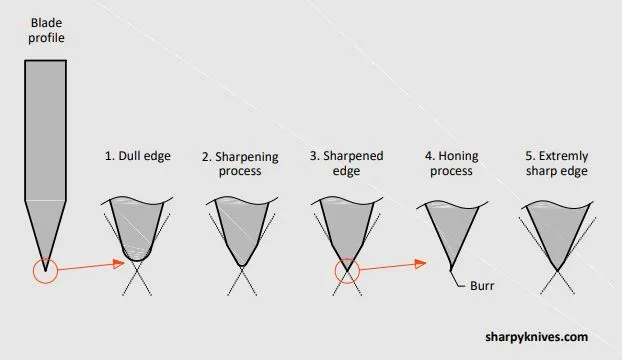
There are quite a few choices available when it comes to methods that can be used to hone a knife, but all the methods will not be suitable for use on Japanese knives.
We will discuss the various methods that can be employed to hone knives and take a look at the best options for Japanese knives and why they are suitable.
There are three main tools that you can use for the process of honing a knife, and with those tools, there are variations that you can apply for different knives and circumstances.
- Honing steels. Sometimes called honing rods, these rods are used as honing devices and can be made from different materials.
- Leather stropping. This is a strip of leather on a hard backing material with a stropping compound on the surface of the leather.
- Whetstone honing. This is the use of high-grit whetstones to hone the edge of the knife.
Honing Steels
Often, when honing is mentioned, the honing steel or honing rod is the first item that comes to mind. Most people have witnessed a chef whipping their kitchen knives with lightning speed across honing steel before using the knife.
While this type of honing device works, it is not suitable for all types of knives. But let’s take a look at the different versions of honing steels and what they are appropriate for.
Types Of Honing Steels
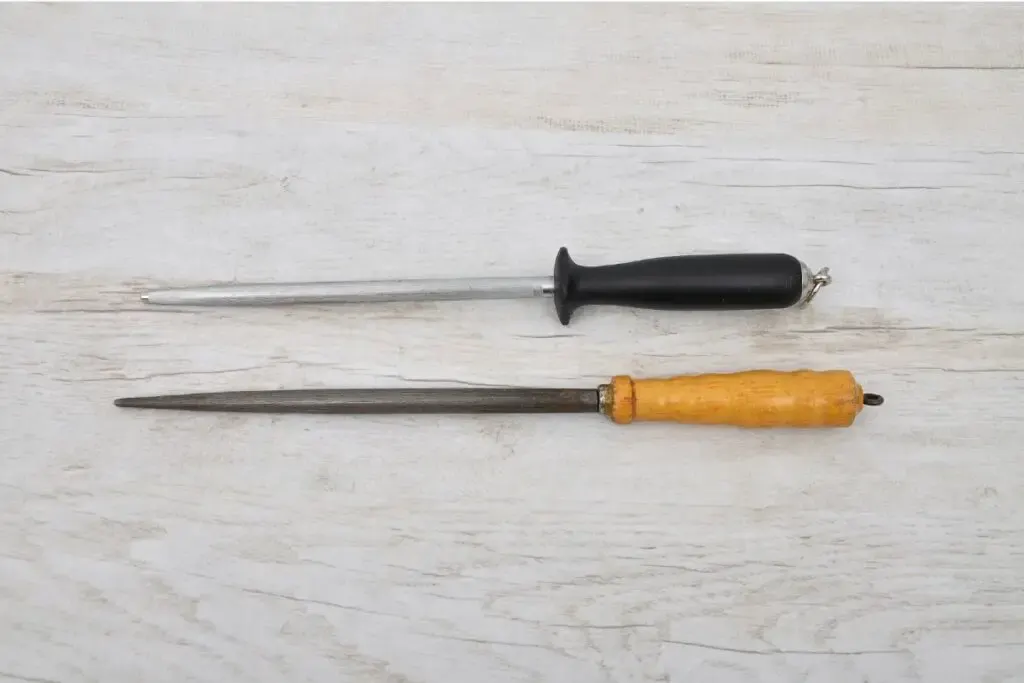
There are 3 main types or categories of honing steels that are available on the market for keeping the edge of your knives in tip-top shape.
- Steel honing rods.
- Ceramic honing rods.
- Diamond honing rods.
Steel honing rods are very coarse and are often rated at an equivalent of around 200-grit. They are made from steel and have ridges along the length of the rod, which are used to hone the edge of the knife.
Because of the coarseness of these rods, they are not recommended for frequent use but rather when the edge of the knife has deteriorated quite substantially.
Diamond honing rods are made with a fine layer of industrial diamonds as a coating on the surface of the rod. It is this layer of diamonds that cuts into the steel of the knife edge and restores the sharpness of the blade.
They are generally considered to be a medium grit level honing and would generally be used prior to honing on a ceramic rod.
They can, however, be used by themselves and will restore the edge to a good sharpness, but they will not polish the edge as well as a ceramic rod does.
Ceramic honing rods are made from a denser material and will do an effective job of honing knives that require a quick touch-up of the edge.
They are less abrasive than steel and diamond honing rods and are better at polishing the cutting edge of the knife than the steel version.
TIP: Honing or sharpening of a knife, what comes first? Find out the complete answer in the article below:
Sharpen Or Hone A Knife: What Comes First?
Should You Use Honing Rods On Japanese Knives?
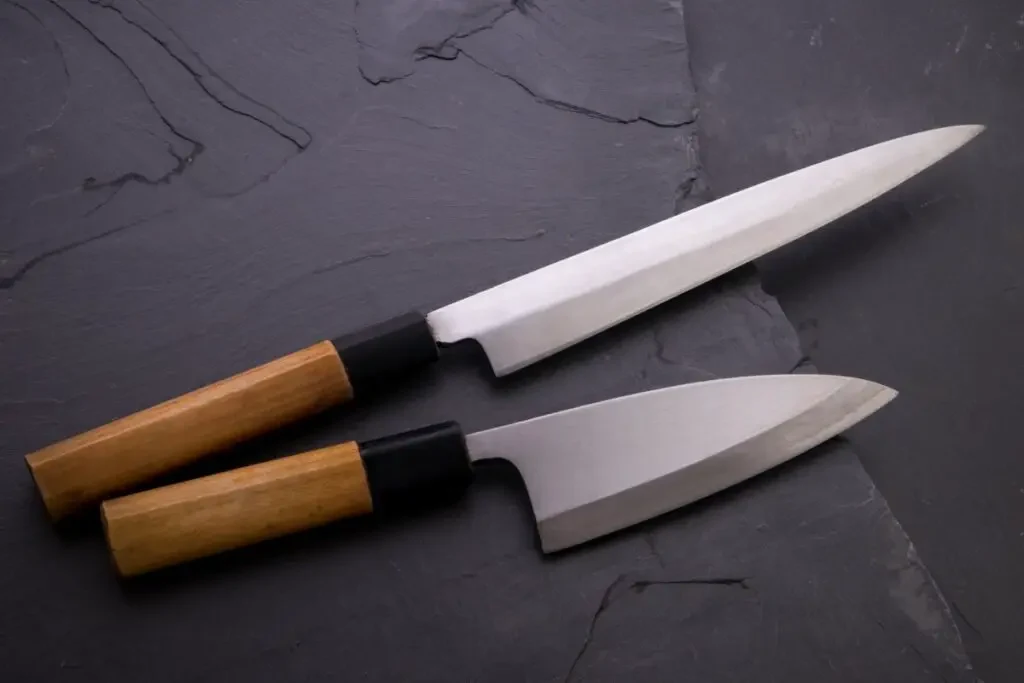
Most recommendations are that honing rods are not suitable for use on Japanese knives. However, many Japanese knife manufacturers make honing rods that are intended for use on their knives.
There is much conjecture that this is simply to satisfy the Western market, which is used to this method of honing kitchen knives.
It is possible to use honing rods on kitchen knives, but they are not appropriate for all kitchen knives, mostly because on hard steel knives, there is the potential to chip the sharp edge of the blade if the honing rod is used incorrectly or too often.
If you are going to use honing steel on a Japanese knife, a ceramic rod would be the recommended choice because it is less aggressive.
It is also only recommended that honing rods are only used on knives that are hardened up to the level of 59 HRC. Beyond this point, honing steel is not recommended because it has the potential to stress the harder, brittle edge of these knives.
Our choice: If you are interested in buying honing rods for Japanese knives we recommend Green Elephant Ceramic Sharpening Rod (Amazon link).
Considering that most Japanese knives are hardened to above 60 HRC, this would preclude the use of a honing rod for the purpose of honing most Japanese knives.
BTW: If you want to know more about Japanese and other knives and their sharpening, check out the books listed above. These books are recommended by professional sharpeners and knife makers (Amazon links):
- Japanese Kitchen Knives: Essential Techniques and Recipes
- The Knifenerd Guide to Japanese Knives
- Knife: The Culture, Craft, and Cult of the Cook’s Knife
- Sharp: The Definitive Introduction to Knives, Sharpening, and Cutting Techniques, with Recipes from Great Chefs
Leather Stropping
Leather strops have been used for hundreds of years to hone the edge of various types of blades. The most iconic use of a leather strop is that of a barber stropping a cutthroat razor before shaving a client.
However, leather strops are more widely used than just this application, and many leather strops are available for kitchen knives and for Japanese knives in particular.
A leather strop usually consists of a strip of leather that is adhered to a hard backing material to give the leather rigidity.
The leather can be used as it is to hone the edge of your knife, but more commonly, an abrasive stropping compound coating is placed on the surface of the leather. This improves the effectiveness of the leather as a honing method.
The stropping compound is usually the equivalent of a very high grit, usually in the range of about 6000-grit. This makes it very gentle on the edge of the knife and also acts to polish the edge of the knife to a mirror-like finish which enhances sharpness.
TIP: Do you want to know more about stropping a knife with leather? Find out the step-by-step guide in the article below:
How To Sharpen Knives With Leather: A DIY Guide
Should You Use A Strop On Japanese Knives?
A strop is one of the recommended methods of effectively and safely honing the edge on any knife, especially your Japanese kitchen knives.
The reason for this is that the leather has a certain amount of “give” to it, which will not flex the edge of the knife to the same degree that a honing rod would.
Stropping is also a more forgiving method, which means that you are less likely to damage the edge of your knife if you don’t perform the technique perfectly and precisely.
Leather stropping is, therefore, recommended as one of the best methods to hone any knife, in particular knives that are hardened to above 60 HRC. This would include all Japanese knives.
Whetstone Honing
Whetstone sharpening is generally considered to be the best method to sharpen Japanese knives because of the hardness of the steel that these knives are made from. But can a whetstone be used for honing a knife?
The answer to this question is yes, whetstones can be used to hone a knife, but you will need to use a high-grit stone for this purpose.
Whetstones that are of a lower grit will remove too much material from the edge of the knife for the purpose of honing. For this reason, whetstone honing stones are generally considered to be stones that are in excess of 3000-grit.
Stones that are up to about 6000-grit would be considered honing stones as well but will perform the honing task much slower than a 3000-grit stone because they remove material much slower than the 3000-grit stone.
Stones above the 6000-grit level are considered to be polishing stones and would only be used if a mirror finish is desired on the knife edge.
Our choice: If you are interested in buying whetstone for honing Japanese knives we recommend and use SHAPTON Ceramic KUROMAKU #5000 (Amazon link).
Should You Hone A Japanese Knife On A Whetstone?
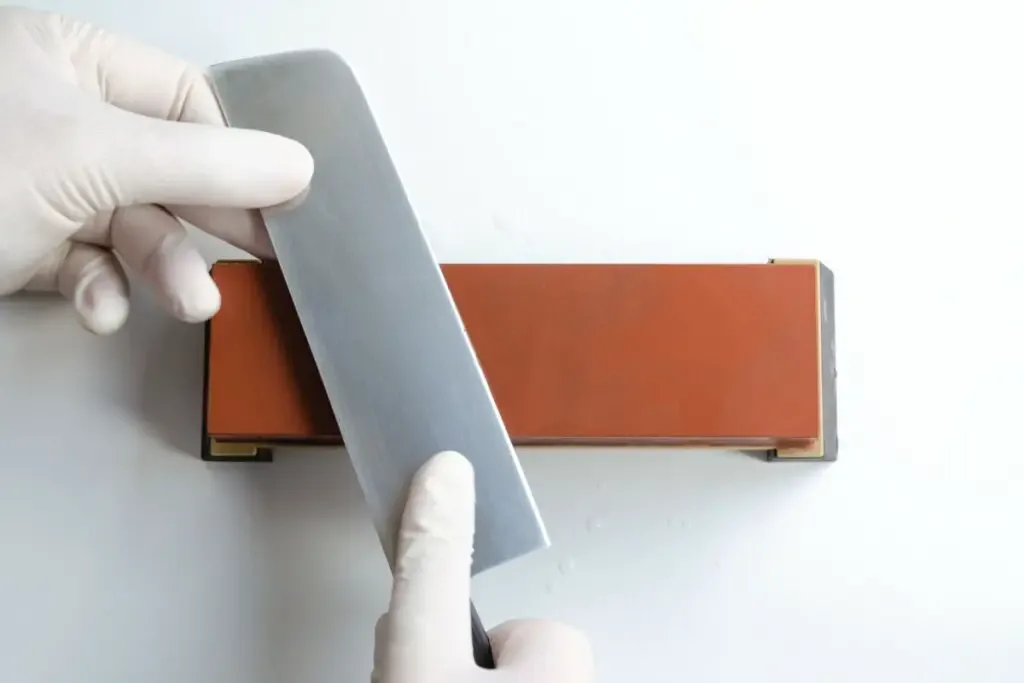
Honing on a whetstone is accepted as a suitable method of honing Japanese knives and does not take a long time. Whetstone honing and stropping take about the same time to properly hone the edge of a knife, but the whetstone requires a more precise technique.
The same technique that is applied to sharpening knives on whetstones is applied when honing knives on whetstones.
This takes practice to develop the appropriate skill to keep the angle of the blade at the same level throughout the stroke of the blade across the stone.
Whetstone honing is an effective and appropriate method for honing Japanese knives but takes time to master.
Honing the knife incorrectly on a whetstone could result in the knife becoming duller at the end of the process than it was when you started honing.
TIP: Whetstones come in many different types when it comes to the grit level, the quality of the stone, and the cost of the stone. It is very important to choose and buy the right whetstone for a given purpose. In the article below, you will find out what you should look for when buying a whetstone!
How To Choose And Buy A Whetstone: The Ultimate Buyer’s Guide
Know Your Knife
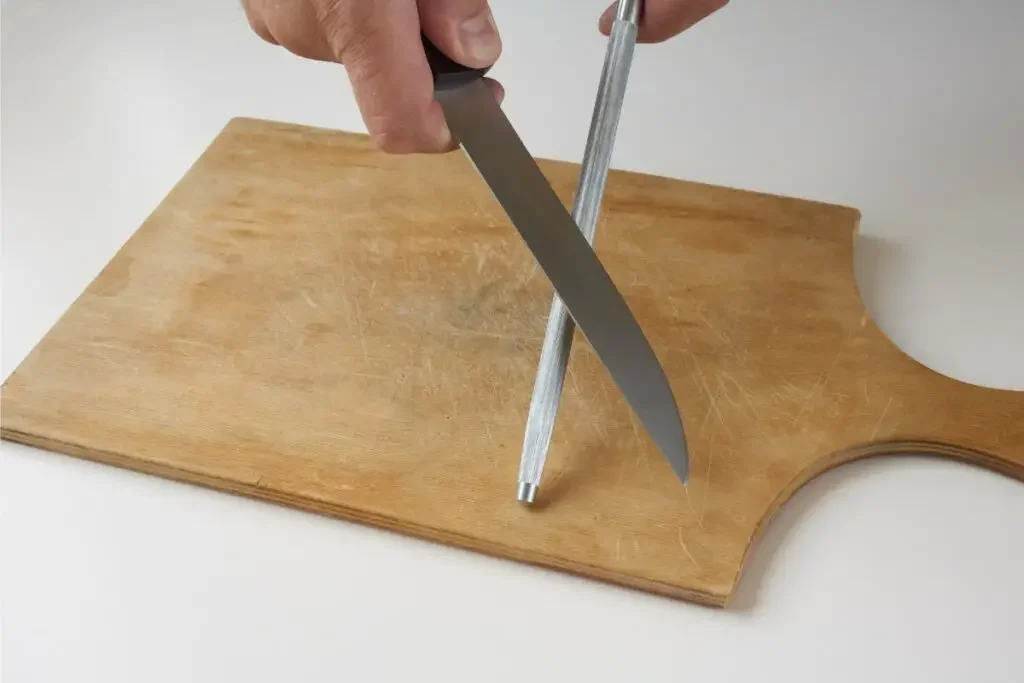
To select the best stropping method and tool for your knives, it is important to know your knife and what steel and preferably what Rockwell hardness or HRC the knife has been hardened to.
The HRC value of the knife will be an indicator of the type of honing instrument and method you can apply to maintain the edge of the knife.
Genuine Japanese knives are generally made from very hard steel, such as VG-10. These knives are hardened to in excess of 60 HRC.
Recommendation: If you are interested in buying Japanese knives (made by Hayate Yoshihiro) we recommend and use them you can find them by clicking here (Amazon link).
Western kitchen knives are made from softer steels and only hardened to between 57 and 59 HRC. This results in softer and more flexible steel, which also makes the thin sharp edge more flexible.
This means that Honing rods can be used safely on Western-style kitchen knives and will be effective in honing the edge without the risk of damage.
Leather strops and whetstone methods of honing can also be used to hone Western knives, but generally, the honing rods or honing steels are faster and more convenient.
For Japanese knives, honing rods are not recommended unless they are below the 60 HRC hardness level. For Japanese knives, the leather strop or the whetstone honing method is preferred and is safer to use with less risk of damaging the edge.
Of the two methods, the leather strop is the most forgiving and would be recommended as the best method of stropping a knife for a beginner.
How Often Should You Hone Your Knife?
The frequency with which you hone your knife will largely depend on the steel it is made from, how often you use your knives and your chosen method of honing.
If you have Western knives, you can use a honing rod daily or weekly on the knife, depending on the level of use the knife gets.
For Japanese knives, stropping can be done daily because it is the least aggressive of the methods of honing the knife. Honing on the whetstone can be done every few days, but once again, this will depend on the usage of the knife.
Conclusion
In conclusion, you should most definitely be honing your Japanese kitchen knives, but you need to be selective in your honing method.
For most Japanese knives, the best method of honing is with a leather strop or a high-grit whetstone of about 3000-grit.
If honing a knife is a new process for you, then the safest way to restore the sharpness of the edge on your Japanese knife is to get yourself a good quality strop combined with a stropping compound.
TIP: Japanese knives are, without a doubt, some of the best knives on the market. Unfortunately, many times we encounter their fakes. In the article below, you will find 8 features to watch out for in order not to buy a fake Japanese knife!
Spotting FAKE Japanese Knives: 8 Features To Watch Out For
